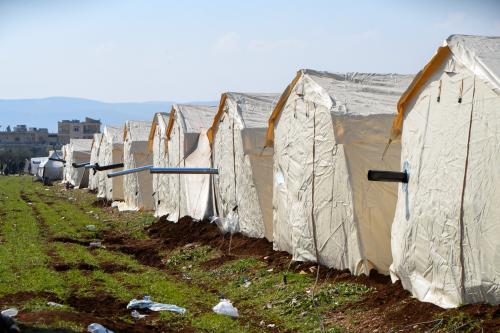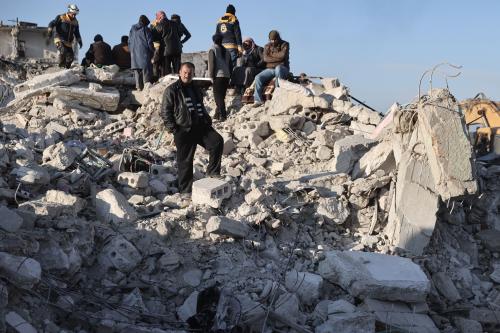I’d never been to Central Asia before and so when we planned a workshop in Bishkek, Kyrgyzstan, I looked forward to learning about displacement and disasters in this part of the world. Together with UN OCHA (Office for the Coordination of Humanitarian Assistance), the workshop focused on protection in natural disasters for representatives of governments, UN agencies, Red Cross/Red Crescent national societies and civil society organizations from seven countries in Central Asia and the Caucasus.
Disasters are common in this region and governmental capacity to respond to – and especially to prepare for – disasters varies a lot within the region but is in most cases limited. Tajikistan, for example, has around 9000 earthquakes a year – most of which are small but the possibility of a major earthquake in the future is a frightening one. A report by my colleague, Johannes Linn outlined both the risks of earthquakes in this region and the inadequate government capacity to prepare for it. As he wrote two years ago, “the bottom line is that there has been little progress in this critical area [preparedness and response capacity] since the collapse of the Soviet Union 20 years ago, and the risk of a major disaster possibly on the scale of Haiti, is a real threat…If anything, the ability of Central Asian countries to respond to a major disaster today is less than in Soviet days.” A report by UNDP last year made essentially the same point – that both national and regional preparedness had declined since the Soviet days. Earthquakes can occur, of course, in both rural and urban areas but there is particular fear of a major earthquake striking an urban area, where populations are concentrated and where it’s not clear how many structures are designed to be earthquake-resistant. I was glad to see the active role being played by UN agencies in carrying out contingency planning throughout the region.
In addition to the dangers from earthquakes, the region regularly experiences river flooding and landslides and there is growing concern that climate change will lead to increased flooding from glacier mountain lakes.
In addition to the dangers from earthquakes, the region regularly experiences river flooding and landslides and there is growing concern that climate change will lead to increased flooding from glacier mountain lakes. There are thousands of lakes in Central Asia and as glaciers recede, more lakes are likely to be formed, dramatically increasing the risk of what are called glacier lake outburst floods. People at the workshop, however, did not seem particularly concerned about climate change; other issues seemed much more urgent. But there is a possibility that these glacier lake outburst floods could affect neighboring countries.
And there are other trans-border dimensions. A governmental representative from Uzbekistan noted that landslides from Kyrgyzstan’s Fergana Valley could affect Uzbekistan as well – a source of particular concern given that there are a significant number of uranium tailings in the Fergana Valley, a legacy from the Soviet times. Many of these sites are undoubtedly degraded. I had never thought about the possibility of ‘radioactive landslides’ before and wondered why this possibility hadn’t received more attention.
You would think that with countries facing similar and interrelated threats from natural hazards, there would be strong incentives to cooperate on preventing and preparing for disasters. After all, working together on natural disasters is generally less politically controversial than trying to resolve political conflicts. I was thus encouraged before I set off for Kyrgyzstan by Johannes Linn’s upbeat report last year about regional cooperation. But although there were open and cordial exchanges between participants from different countries in the workshop, there were few signs of concrete steps to promote regional cooperation. For example, in spite of an optimistic launch of a new Central Asian Center for Disaster Response and Risk Reduction – with financial support from the European Union regional support for the initiative seems to be faltering. Three governments have to agree to join for it to come into force, but so far only two governments have signed up; Kazakhstan and Kyrgyzstan and so, at least for now, the Center is on hold. Water and energy management issues are controversial in the region, as evidenced by the opposition to the construction of the Rogun hydropower plant in Tajikistan. Construction of this dam (which, when completed, will be the highest in the world) has been in the works for decades. But there are questions about the impact of the dam on neighboring Uzbekistan and controversies about the planned resettlement of 30,000 people from areas likely to be flooded by the dam.
Although the workshop focused on natural disasters, everyone was conscious of the June 2010 violence in southern Kyrgyzstan, in which over four days mobs had burned largely Uzbek homes, killing some 400 people (according to official figures) and destroying more than 2,000 homes. Some 400,000 people were displaced, including over 100,000 who crossed the border as refugees into Uzbekistan. On one level, the crisis was over quickly. Within weeks, the refugees and most of the IDPs had returned and over the past two years, many of the destroyed houses have been rebuilt. The UNHCR representative told me that today there are only 3,200 IDPs left although far larger numbers – around 172,000 are still considered to be affected by the June events. This is down from the July 2010 figure of 75,000 IDPs and 400,000 affected. In comparison with many other situations where displacement drags on for years, this was positive indeed.
But although the situation is presently calm, people admitted that there is still tension and the possibility of another violent outbreak couldn’t be ruled out. This is reinforced by disturbing reports of discrimination and harassment of the region’s ethnic minority, the Uzbeks. All of these countries have complex ethnic relationships. Kyrgyzstan, for example has some 80 distinct ethnic groups; while the Kyrgyz make up about 40%, and the Uzbeks slightly under half in the southern region of Osh, the local governments are dominated by ethnic Kyrgyz.
As happens in most major emergencies, there was an influx of international organizations following the violence, but most have since left. And yet the continued presence of international organizations, such as UNHCR and UNICEF, in Osh may serve as an effective prevention measure for further violence.
There is considerable migration within and beyond the region. Uzbeks who can’t find jobs in Kyrgyzstan have gone to Russia as economic migrants, leaving wives and children behind, often sending money home. In fact, the International Organization for Migration reports that in 2009, remittances from overseas workers totaled USD 882 million.
Usually when I think of natural disasters and displacement, the cases that come immediately to mind are the Haitian earthquake, the Japanese earthquake/tsunami, and the massive flooding in Pakistan and Colombia. But this workshop in Bishkek reminded me that many countries which rarely feature in Washington DC headlines are also vulnerable to disasters. Perhaps because they aren’t regularly on the international radar screen is precisely the reason that practitioners and academics alike need to pay more attention to them.


Commentary
Op-edCentral Asia: Disasters, Displacement and Human Rights
May 29, 2012